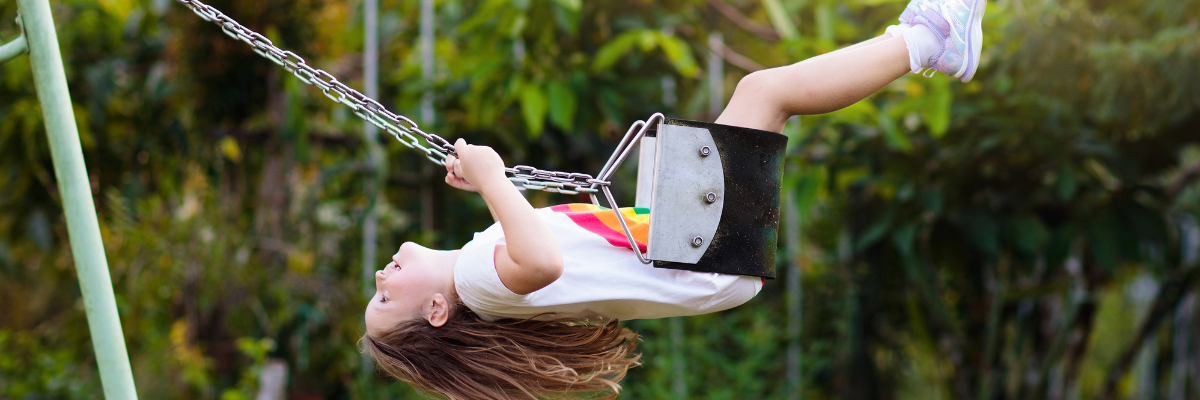What is the Vestibular System?
Vesti-what?!? The vestibular system is made up of the inner ear, vestibulocochlear nerve that communicates between the inner ear and brain, parts of the brainstem, and cortical areas in the brain. The vestibular system responds to head movements like when you nod your head “yes”, shake your head “no”, or tip your head to shake the water out of your ears. It also responds to movements like when you move forward or backwards when you’re sledding, move up and down like when you’re jumping, or when you spin around in circles. Overall the vestibular system helps you figure out where you are in space as you move around your environment so that you can…
- Maintain your gaze on a target while moving your head (vestibulo-ocular reflex)
- Maintain postural control or balance
- Orient yourself to your environment
- React appropriately to your surroundings
- Avoid falls
Check out this helpful resource from Integrated Learning Strategies, who breaks down the vestibular system as an internal GPS system for the body!

What is vestibular dysfunction?
Vestibular dysfunction may be attributed to deficits or impairments of the inner ear, vestibulocochlear nerve, brain, or brainstem. As adults we may notice difficulties with our vestibular system due to symptoms like dizziness, vertigo, trouble keeping objects in focus while moving our head, or changes in our balance. Children who have vestibular concerns may not realize that they are dizzy or that movement of letters when reading is atypical if they have always experienced these symptoms. This can make diagnosing vestibular concerns hard and can often times be mistaken for other issues (learning disabilities, behavior problems etc.) due to a child’s inability to explain the symptoms they are experiencing.
Migraines, Benign Paroxysmal Vertigo of Childhood (BPVC), and Traumatic Brain Injuries are the most common causes of childhood vertigo. Ocular disorders, inner ear malformations, labyrinthitis (inflammation of the inner ear), and neuritis (inflammation of the vestibulocochlear nerve) are also common causes.
As a parent, here are a few signs and symptoms to watch for regarding vestibular dysfunction:
- Head tilted to the side
- Easily stressed, anxious, or upset with quick changes in movement or being on unstable, uneven, or taller surfaces
- Nausea and vomiting
- Imbalance or frequent falls
- Vertigo or dizziness
- Reduced cognitive performance
- Decreased consciousness or arousal
- Poor spatial awareness, navigation, or orientation
- Ringing in ears
- Spontaneous and involuntary eye movements
- Motion/car sickness
- Constant need for movement or taking unsafe risks for various positional changes or movement patterns
What should you do if your child is experiencing vestibular dysfuntion?
First and foremost, consult your child’s pediatrician to discuss your concerns. You may be referred to a neurologist for further evaluation and recommendations. If your child’s pediatrician or neurologist determines that your child would benefit from Physical or Occupational Therapy treatment, your child may be referred for an initial OT and/or PT evaluation.
How can a pediatric occupational therapist or physical therapist help with vestibular concerns?
- During the initial evaluation your therapist may…
- Assess how your child’s eye move in a variety of situations
- Screen for abnormal eye movements
- Assess your child’s visual acuity
- Test your child’s balance while static or standing still, as well as their dynamic balance while on a variety of surfaces, while they are moving, or while they are performing a task
- Assess how your child responds to various positional changes and movement patterns
- Assess for seeking or avoidance behaviors of various positional changes or movements
- During treatment your therapist may…
- Use balance beams, obstacle courses, balance boards, single leg stance activities, etc. to challenge and improve your child’s balance.
- Use stair training, climbing a rockwall or ladder, standing on a platform swing, etc. to address gravitational sensitivities and challenge balance at various heights.
- Use swinging, spinning, rolling in a foam cylinder, sliding down slide, riding on a scooter board, etc. to help strengthen your child’s vestibular system. These activities will also potentially help delay the onset or reduce the severity of your child’s dizziness.
- Use specific activities involving movement of their eyes and head to strengthen their vestibular system.
If you have concerns about your child’s vestibular function, motor development, sensory difficulties or anything else, call Carolina Therapy Connection at 252-341-9944 or email us at in**@***********************on.com to get started today! We accept all major insurances and would love to help your family and kiddo maximize their independence and potential to grow healthy and strong!
Blog Written By: Joann Flaherty, PT, DPT and Jessica Reynalds OTD, OTR/L
References:
- Casselbrant ML, Villardo RJ, Mandel EM. Balance and otitis media with effusion. Int J Audiol. 2008;47(9):584-589.
- Christy, J., Beam, M., Mueller, G., & Rine, R. (2019). Just Screen It!! (Part 2): Developmental Disability, Vestibular Deficit, or Both?. Presentation, APTA Combined Sections Meeting.
- Christy, J., & Rine, R. (2019). Just Screen It!! (Part 1): Developmental Disability, Vestibular Deficit, or Both?. Presentation, APTA Combined Sections Meeting.
- Lin, C. (2019). Vestibular Rehabilitation Intervention. Presentation, East Carolina University.
- Salami, A., Dellepiane, M., Mora, R., Taborelli, G., & Jankowska, B. (2006). Electronystagmography finding in children with peripheral and central vestibular disorders.International Journal of Pediatric Otorhinolaryngology, 70(1), 13-18. doi:10.1016/j.ijporl.2005.05.001
- Wiener-Vacher, S. R. (2008). Vestibular disorders in children. International Journal of Audiology, 47(9), 578-583. doi:10.1080/14992020802334358


